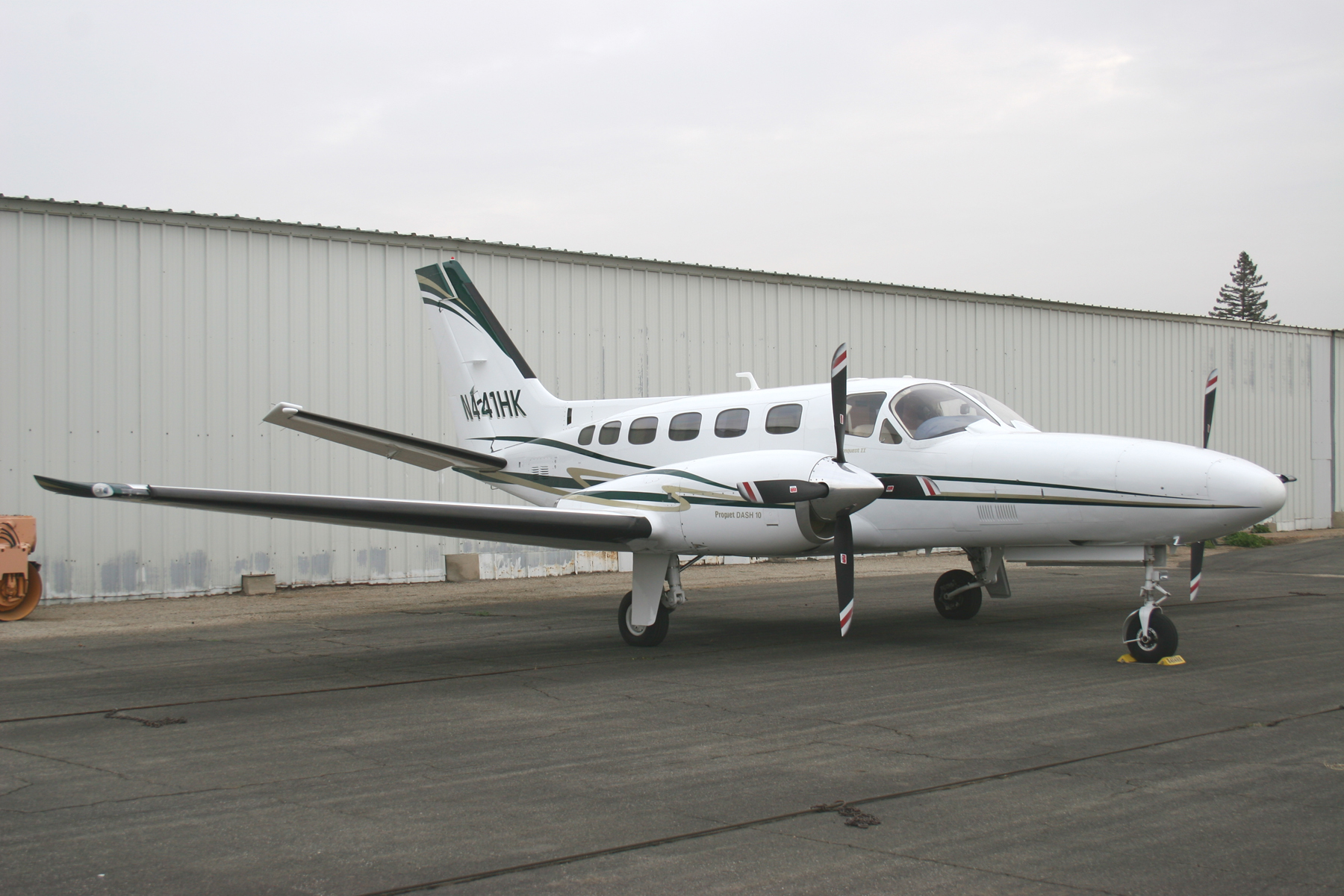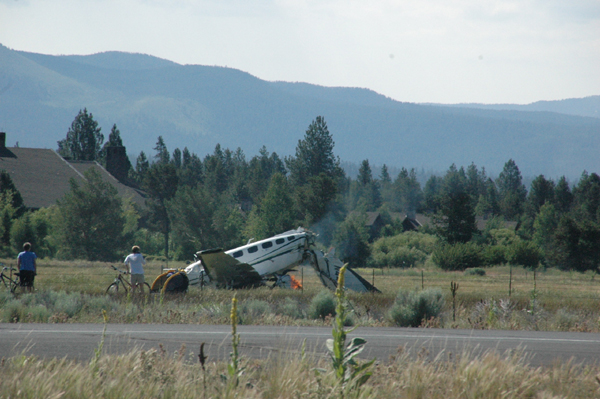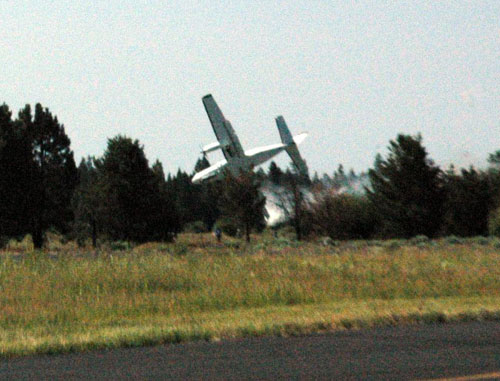Zone
Crash of a Cessna 441 Conquest in Sunriver: 1 killed
Date & Time:
Jul 16, 2008 at 1015 LT
Registration:
N441HK
Survivors:
No
Schedule:
Bakersfield - Sunriver
MSN:
441-0336
YOM:
1984
Crew on board:
1
Crew fatalities:
Pax on board:
0
Pax fatalities:
Other fatalities:
Total fatalities:
1
Captain / Total hours on type:
277.00
Aircraft flight hours:
5643
Circumstances:
The pilot was executing a day visual flight rules full-stop landing and touched down on the main landing gear near the approach end of the runway. Soon after the initial touchdown, the airplane became airborne again. Instead of initiating a go-around, the pilot attempted to continue the landing sequence. During that attempt, the airplane bounced on the runway three or four times, each time the rebound back into the air and the runway contact was more severe. During the last contact the airplane impacted the runway with sufficient force to result in the failure of the right main landing gear actuator rod, and in the right propeller contacting the runway surface multiple times. The pilot then initiated a go-around, but since the right engine had failed due to the multiple propeller strikes, the airplane produced asymmetrical thrust and began to roll to the right, veering off the right side of the runway. Soon thereafter its right wing collided with a tree and the airplane impacted terrain in an open field. The airplane was consumed by fire shortly after the collision. Post crash inspection found no evidence of mechanical failure or malfunction with the airframe or either engine.
Probable cause:
The pilot's misjudged landing flare and improper recovery from a bounced landing, and the pilot's failure to maintain directional control during the go-around after one of the airplane's propellers struck the runway.
Final Report:



Crash of a Piper PA-60 Aerostar (Ted Smith 602P) in McFarland: 3 killed
Date & Time:
Nov 9, 2007 at 1200 LT
Registration:
N6895Z
Survivors:
No
Schedule:
Roseburg – Bakersfield
MSN:
62-0918-8165043
YOM:
1981
Crew on board:
1
Crew fatalities:
Pax on board:
2
Pax fatalities:
Other fatalities:
Total fatalities:
3
Captain / Total hours on type:
15.00
Aircraft flight hours:
3780
Circumstances:
The accident flight was the pilot's first 700 nm cross-country flight in the newly purchased airplane. Prior to departing he had the airplane refueled with the airplane on a slope. The individual who refueled the airplane estimated that the left wing tip was 12 to 14 inches lower than the right wing tip. He stated that the pilot was very concerned about getting as much fuel in the airplane as possible because of his up-coming flight. After climbing to his assigned cruising altitude of 21,000 feet and about two hours into the flight the pilot reported to ATC that he needed to divert. During the descent the pilot reported that he was experiencing a fuel problem and that one engine was sputtering. Two minutes later the pilot declared an emergency and reported that both engines were sputtering. The pilot reported at that time that he had 15 total gallons of fuel remaining A witness to the accident reported that he saw the airplane flying southbound and that the wings were rocking side-to-side. The airplane then rolled to the right before crashing into the citrus grove. Examination of the airframe revealed no pre-impact failure to any flight control surface or control system component. The power plant investigation did not disclose any pre-impact mechanical failure of any rotating or reciprocating component of the engine. Interviews with pilots who had flown with the accident pilot indicated that this was his first flight above 13,000 feet in the accident airplane, and was probably his longest distance attempted flight since he had purchased the airplane. According to information contained within the Pilot's Operating Handbook and FAA Approved Airplane Flight Manual (VB-1190), "The full amount of usable fuel is based on the airplane sitting on a level ramp, laterally level, and longitudinally (approximately 1 1/2 degree nose up) with each tank fueled to 0.6 inches below filler neck. The wing tanks are extremely sensitive to attitude and if not level, they cannot be fueled to the full usable capacity." This information is also included in the FAA Type Certificate Data Sheet No. A17WE under the section Data Pertinent to All Models, Note 1.
Probable cause:
The pilot's inadequate preflight preparation and improper fueling procedures that led to fuel exhaustion.
Final Report:
Crash of a Cessna 414 Chancellor near Kernville: 1 killed
Date & Time:
May 19, 1996 at 1018 LT
Registration:
N111AH
Survivors:
No
Schedule:
Bakersfield - Kernville
MSN:
414-0089
YOM:
1970
Crew on board:
1
Crew fatalities:
Pax on board:
0
Pax fatalities:
Other fatalities:
Total fatalities:
1
Captain / Total hours on type:
213.00
Circumstances:
Recorded radar data showed the aircraft was flying in an area of mountainous terrain. Mountain tops in the area were reported to be obscured. Radar data showed that the aircraft first descended to a low altitude as it flew up a valley, then it climbed until impacting rising terrain about 7,200 feet msl. Wreckage was scattered over 300 feet up the mountain slope. About 32 miles southwest at Bakersfield (elevation 507 feet), the 1000 pdt weather was in part: 4500 feet scattered, 6000 feet overcase, visibility 20 miles, wind from 260 degrees at 10 knots. Nearby residents reported that the mountain was obscured in clouds at the time of the accident. During postmortem toxicology tests, a low level of ethanol (23 mg/dl) was detected in muscle fluid specimen, probably from post-mortem production. No ethanol was detected in brain fluid.
Probable cause:
VFR flight by the pilot into instrument meteorological conditions (IMC), and his failure to maintain sufficient altitude/clearance from rising/mountainous terrain. Factors relating to the accident were: the terrain and weather conditions.
Final Report:
Crash of a Piper PA-46-350P Malibu Mirage in Bakersfield: 2 killed
Date & Time:
Feb 6, 1990 at 1548 LT
Registration:
N8888M
Survivors:
No
Schedule:
Porterville – Redlands
MSN:
46-22091
YOM:
1989
Crew on board:
1
Crew fatalities:
Pax on board:
1
Pax fatalities:
Other fatalities:
Total fatalities:
2
Captain / Total hours on type:
51.00
Aircraft flight hours:
62
Circumstances:
Before takeoff, pilot was advised of IFR conditions along 1st part of route, with flight predictions for occasional moderate turbulences below 15,000 feet and mixed icing from freezing level (6,000 feet) to 18,000 feet. He filed IFR flight plan with cruise altitude of 11,000 feet. During departure, pilot was cleared to climb to 9,000 feet and told to expect clearance to 11,000 feet 5 minutes later. Radar data showed aircraft climbed at about 1,500 feet/minute and 100 knots, slowing slightly above 8,000 feet. At abt 9,000 feet, aircraft started to level and accelerate. It then climbed momentarily, deviated laterally from course and entered steep descent. Inflight breakup occurred and wreckage was scattered over 4,100 feet area. Trajectory study showed breakup occurred between 4,500 feet and 6,500 feet as aircraft was in steep descent in excess of 266 knots. Metallurgical examination of wings and stabilizers revealed features typical of overstress separation; no pre-existing cracks or defects were found. The aircraft was recently purchased. Pilot's son indicated principal problem was 'twenty year leap in technology' from previously owned PA-24, that pilot had difficulty with avionics and flight director/autopilot, and that he lacked detail training in autopilot emergencies. Both occupants were killed.
Probable cause:
The pilot's failure to activate the pitot heat before flying at and above the freezing level in instrument meteorological conditions (IMC), followed by his improper response to erroneous airspeed indications that resulted from blockage of the pitot tube by atmospheric icing. Contributing to the accident was spatial disorientation of the pilot.
Final Report:

